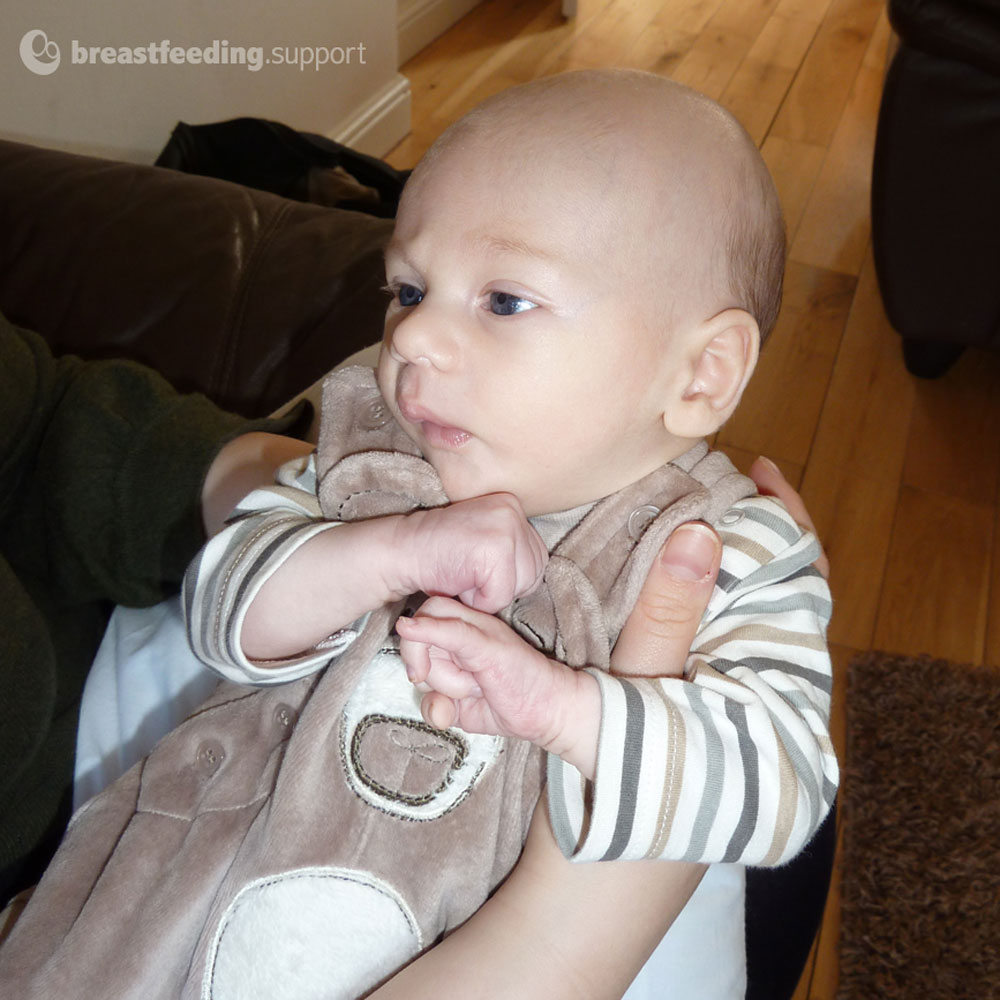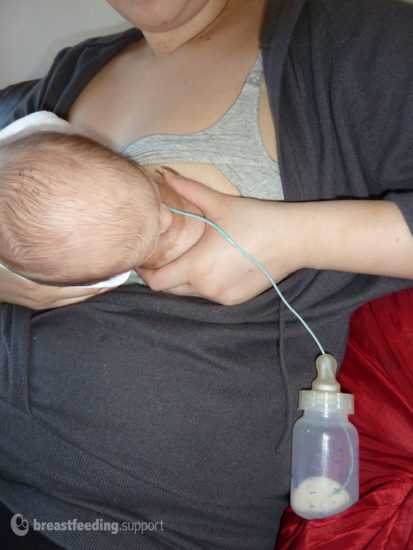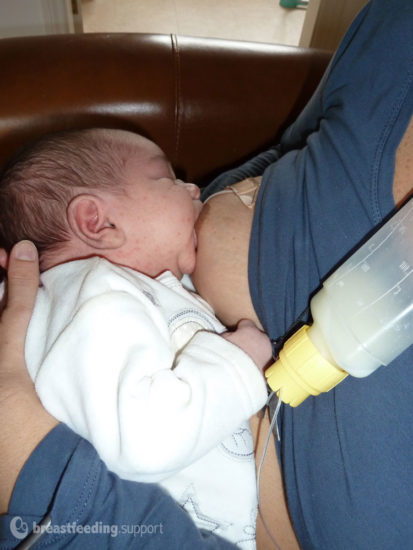Sometimes a breastfed baby may struggle to gain weight, either not gaining weight at all or not gaining enough weight to stay on their growth curve. This article looks at the possible reasons for not gaining weight and what to do to get breastfeeding back on track and baby well fed. This is a companion article to Understanding Your Baby’s Weight Chart and Supplementing an Underweight Baby.
It is important to stay in close contact with a health care professional if your baby is not gaining weight as expected as they will check for any underlying health concerns and be able to monitor your baby’s weight regularly.
What are the reasons for a breastfed baby not gaining weight?
#1 Not enough milk
In most cases the reason for not gaining enough weight is because the baby is not getting enough breast milk. There could be many potential reasons for this from issues of poor latch, breastfeeding on one breast per feed or on a schedule, to other causes of low milk supply such as insufficient glandular tissue, hormonal issues, delayed onset of lactation and more. An International Board Certified Lactation Consultant (IBCLC) is the ideal breastfeeding specialist to help you find the Reasons for Low Milk Supply.
#2 Health issues for baby
Sometimes underlying health issues with the baby may be identified as the cause of poor weight gain e.g. breathing or cardiac problems, neurological issues, milk allergy, anaemia, genetic syndrome, low or high muscle tone, or undetected tongue tie (see below). Occasionally, lactose overload can be a cause of low weight gain.
#3 One thing leads to another
Once a baby is underweight they can become very sleepy and not very interested in feeding. Or they may seem hungry, but quickly fall asleep at the breast instead of actively feeding. This type of infrequent feeding causes a mother’s milk supply to drop which adds to the problem of low weight gain in a vicious cycle.

Is my baby gaining enough weight?
If your baby is gaining some weight, you may wonder if you really do need to be worried or whether it is within normal limits. It may help to read Is My Baby Getting Enough Milk? and Understanding Your Baby’s Weight Chart. The World Health Organisation (WHO) weight charts show the expected growth curves seen in healthy breastfed babies. There are separate charts for boys and girls since they grow slightly differently. You can download these charts and plot your baby’s weight yourself (weight for age 0-6 months GIRLS & BOYS) so you can see how your baby’s growth compares. There are also growth apps that can record baby’s weight on your phone that use the same charts.
Normal gain
The WHO charts show that weight gains of 30g‑40g per day in the first 3 months are to be expected when a baby is growing well. This slows down between 3‑6 months to an average gain of 20g per day.
Crossing centiles?
If your baby is gaining less than around 30g‑40g per day in the first 3 months or less than about 20g per day between 3‑6 months, their growth curve may start to drift away from their weight-for-age curve. It may begin crossing the pre-drawn centile lines in a downward direction. See Understanding Your Baby’s Weight Chart for more information on centiles and examples of curves that show faltering weight gain.
Crossing centile lines on the WHO chart may just be a sign that your baby’s birth weight was inflated, perhaps you were on an IV drip during labour. Or it may mean that your baby is destined to be tiny and petite just like his parents, or long and lean like Uncle Larry. Or it may be because he has been poorly recently. However this can’t be established by someone who has never seen you and your baby on Dr Google or in a Facebook thread. If your breastfed baby is consistently not gaining weight (or negligible weight) consider seeking the help of an IBCLC lactation consultant to work with you and your health professionals; sooner rather than later. There is no advantage to waiting to see if the problem disappears.
Hungry or satisfied?
In addition to monitoring weight gain, it is useful to be aware of some typical characteristics of both an underweight baby and one who is getting enough milk:
- The hungry/underweight baby. A baby who has not had enough milk may be tense, with his arms bent at the elbow and held close to his body. He may fall asleep with his hands in tight fists and look worried with a frown on his face. A hungry baby may seem fussy and want to stay at the breast for long periods which may be mistaken for breastfeeding “continuously” but actually he is not actively sucking or swallowing milk. Fussy behaviour or difficulty sleeping might also be attributed to colic, reflux, silent reflux or intolerance to mother’s diet instead of hunger. Alternatively a hungry baby may sleep a lot and be mistaken for a “good baby”. A very underweight baby can have loose skin and facial features that look like a little old man and he may have infrequent wet or dirty nappies. Signs of dehydration include dry lips, mouth and tongue, drowsiness, sunken eyes and not many wet nappies.1
- The baby who is full. When your baby has had enough milk or is full to satiety he will usually fall asleep and let go of the breast on his own after a period of active sucking and swallowing. He will have relaxed hands and probably a ‘milk drunk’ satisfied expression. He will have plenty of wet and dirty nappies each day and good weight gain (see Is My Baby Getting Enough Milk? for more information).

Next steps
In an ideal scenario the health visitor or midwife will pick up on genuine poor gain at the first sign of a problem and refer the mother to a breastfeeding specialist to protect breastfeeding and ensure the baby gets more milk. A close eye will be kept on the baby’s weight gain by weighing regularly (e.g. weekly or more often). An IBCLC lactation consultant will usually take a full medical history, study the baby’s weight chart, watch a breastfeed from start to finish and put a plan in place to increase baby’s intake of milk to get them back on track.
Step one: feed the baby
If a baby is considerably underweight it may take time to build his mother’s milk supply and formula may be needed at first unless donor milk is available or unless the baby is of an age when solid foods can fill the gap. Mothers who can’t access donor milk and are reluctant to use formula may need gentle counselling to understand that the priority is to rebuild their baby’s bodyweight and energy levels; they need more food. It can help the mother to think of formula as a necessary medicine to supplement direct breastfeeding.
If a mother can pump enough breast milk then that can and should be used as the supplement instead. But it is very likely that, for whatever reason, the baby is not able to get enough milk from the breast themselves and the first rule is to get the baby fed… to satiety (i.e. until they are full).
How to supplement the underweight baby
Top-up supplements can be given to a baby by
- an open cup: baby must be awake and alert
- supplementing at the breast—when a small tube delivers supplement alongside the nipple (see pictures below)
- finger-feeding—baby suckles a finger with a feeding tube attached
- bottle and teat. Using a bottle to give supplements after each breastfeed may be a good choice for the underweight baby who keeps falling asleep without feeding well. Although bottles can sometimes cause problems breastfeeding for some babies due to nipple preference or confusion, these Tips to Bottle Feed a Breastfed Baby can help. Topping up by bottle before a breastfeed is another option.
For more information on supplementing your baby see Supplementing an Underweight Baby. With more milk inside him, your baby will have more energy to breastfeed effectively.

Step two: build mother’s milk supply
With baby’s calorific needs met in the short-term with supplements, work can begin on maximising a mother’s milk supply. After breastfeeding from both breasts for a combined total of around 20-30 minutes, time spent pumping or hand expressing will stimulate the breasts more effectively than continuing to breastfeed for hours at a time with a baby who isn’t really drinking (and isn’t gaining weight). See How to Make More Breast Milk and How to Increase Milk Supply When Pumping for ideas to maximise your supply.
Catch up growth
If your baby has been short on calories for some time, there will usually be good catch up growth once they are getting more milk. Gains of at least 56g per day2 can be expected for several days or longer. Weight gains up to 120g per day could be possible 3. Your baby may become very interested in feeding and may take more and more supplement when their appetite returns and they start to catch up.
All children with failure to thrive need additional calories for catch-up growth (typically 150 percent of the caloric requirement for their expected, not actual, weight).
Unless the infant has an underlying medical problem, failure to begin catch-up weight gain means insufficient supplement is being given.
Watch out for poor advice
Hopefully your health professional will be very knowledgable about breastfeeding. Unfortunately they may not be or you may come across poor advice from elsewhere. Advice to keep to one breast “to reach the hind milk” will generally reduce your milk supply (read more here and here). Advice to feed more often or for a certain number of minutes isn’t helpful if that baby isn’t very good at feeding, why spend more time doing something that already doesn’t work? Alternatively the advice you hear may be to supplement with formula—without addressing the underlying breastfeeding problems. Keeping to one breast or suggesting formula instead of breastfeeding without actively trying to increase a mother’s milk can undermine breastfeeding and cause early weaning.
Seek a second opinion
At the other extreme, a health professional or the mother herself may be so pro-breastfeeding that she is overly optimistic about the low weight gain picking up soon all on its own. They may continue to monitor the situation without taking action when weight gain is as low as 12g per day or even less. They may think that if baby is following his own curve he is OK, even if it is well below the chart. If this is the case for you, asking for a second opinion from a paediatrician will ensure that your baby is fit and healthy and there are no health concerns. After all a few healthy babies will be on the 1st centile. If not, an IBCLC can help you make a tailor made plan to increase your milk supply and get your baby taking more calories.
NICE guidelines
NICE (National Institute for Health and Care Excellence) guidelines recommend further medical assessment for faltering growth if a baby’s weight falls
- across one or more centile spaces if they were born below the 9th centile
- across two or more centiles if birthweight was between the 9th and 91st centiles
- across three or more centiles if birthweight was above the 91st centile.4
Avoid Dr Google and Nurse Facebook
When a mother desperately wants to breastfeed, and is worried about her baby, she may look to search engines on the internet and social media platforms. She may find breastfeeding forums where mothers reassure her that their babies didn’t gain much weight either but they were fine, and that she is doing great, and that breastfeeding is the best thing for her baby. They may tell her “carry on hun” or another favourite “it sounds just like a tongue-tie”. However these cheer leaders often don’t ask any important questions; they can’t see the baby’s weight chart; they are not trained breastfeeding specialists. Following this kind of advice may lull the mother into a false sense of security while her baby continues to fail to thrive and her milk supply gets less and less.
A note on tongue-tie
Although it may be the latest trend on Facebook, not everything that goes wrong in the breastfeeding world is about tongue-tie. Many low weight gain babies will show poor tongue action because they are very tense and very hungry. Yes, there may be a tight frenulum (the membrane under the tongue), but let your IBCLC or experienced tongue tie practitioner advise you, not Dr Google. Dividing a tongue tie and then expecting everything to turn out peachy as if by magic is lulling you into a false expectation. If a baby is 25-30% below their expected weight for age, your milk supply is likely already compromised and waiting around for the magic on the tenuous basis “it can take 2‑3 weeks to work out how to use their tongue” can mean 2‑3 more weeks of slipping behind in calories.
Prevention is better than cure
Unfortunately IBCLCs do come across babies 30% below their expected weight in the community. At this point there may already be a referral to a paediatrician. Social services may even have been called. And everyone will be worried. By getting the right help as soon as there are early concerns, this upsetting situation can hopefully be avoided.
The consequences of inadequate intake of breast milk range from hyperbilirubinemia, infant hunger, and slow weight gain to life threatening, and even fatal, dehydration and starvation.
Summary
A baby who is very under weight may not be able to breastfeed effectively and his mother’s milk supply may be very low. An action plan involves increasing a baby’s calorie intake with supplements, building his mother’s milk supply and finding the underlying reason for low weight gain. There are lots of ideas on this website for increasing your milk supply to get you started, but for specialist help consult an IBCLC lactation consultant alongside your doctors. Choose one who can spend the time needed to take a full history, make an individual care plan and liaise with your health care professionals.

